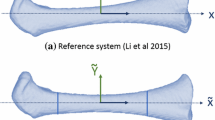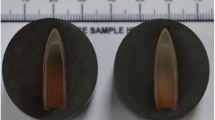Abstract
There is much debate within the forensic community around the indications that suggest a head injury sustained by a child resulted from abusive head trauma, rather than from accidental causes, especially when a fall from low height is the explanation given by a caregiver. To better understand this problem, finite element models of the paediatric head have been and continue to be developed. These models require material models that fit the behaviour of paediatric head tissues under dynamic loading conditions. Currently, the highest loading rate for which skull data exists is 2.81 ms−1. This study improves on this by providing preliminary experimental data for a loading rate of 5.65 ± 0.14 ms−1, equivalent to a fall of 1.6 m. Eleven specimens of paediatric cranial bone (frontal, occipital, parietal and temporal) from seven donors (age range 3 weeks to 18 years) were tested in three-point bending with an impactor of radius 2 mm. It was found that prompt brittle fracture with virtually no bending occurs in all specimens but those aged 3 weeks old, where bending preceded brittle fracture. The maximum impact force increased with age (or thickness) and was higher in occipital bone. Energy absorbed to failure followed a similar trend, with values 0.11 and 0.35 mJ/mm3 for age 3 weeks, agreeing with previously published static tests, increasing with age up to 9 mJ/mm3 for 18-year-old occipital bone. The preliminary data provided here can help analysts improve paediatric head finite element models that can be used to provide better predictions of the nature of head injuries from both a biomechanical and forensic point of view.







Similar content being viewed by others
Data availability
Data is available on request to the authors.
References
Johnson K, Fischer T, Chapman S, Wilson B (2005) Accidental head injuries in children under 5 years of age. Clin Radiol 60(4):464–468. https://doi.org/10.1016/j.crad.2004.09.013
Plunkett J (2001) Fatal pediatric head injuries caused by short-distance falls. Am J Forensic Med Pathol 22(1):1–12
Chadwick DL, Chin S, Salerno C, Landsverk J, Kitchen L (1991) Deaths from falls in children - how far is fatal. J Trauma Injury Infect Crit Care 31(10):1353–1355
Hobbs CJ (1984) Skull fracture and the diagnosis of abuse. Arch Dis Child 59(3):246–252. https://doi.org/10.1136/adc.59.3.246
Wilkins B (1997) Head injury—abuse or accident? Arch Dis Child 76(5):393–397
Reece RM, Sege R (2000) Childhood head injuries: accidental or inflicted? Arch Pediatr Adolesc Med 154(1):11–15
Roach JP, Acker SN, Bensard DD, Sirotnak AP, Karrer FM, Partrick DA (2014) Head injury pattern in children can help differentiate accidental from non-accidental trauma. Pediatr Surg Int 30(11):1103–1106. https://doi.org/10.1007/s00383-014-3598-3
Williams R (1991) Injuries in infants and small children resulting from witnessed and corroborated free falls. J Trauma Acute Care Surg 31(10):1350–1352
Loyd AM (2011) Studies of the human head from neonate to adult: an inertial, geometrical and structural analysis with comparisons to the ATD head. Citeseer
Hajiaghamemar M, Lan IS, Christian CW, Coats B, Margulies SS (2018) Infant skull fracture risk for low height falls. Int J legal Med 1-16
Li X, Sandler H, Kleiven S (2019) Infant skull fractures: accident or abuse?: Evidences from biomechanical analysis using finite element head models. Forensic Sci Int 294:173–182
Burgos-Flórez F, Garzón-Alvarado DA (2020) Stress and strain propagation on infant skull from impact loads during falls: a finite element analysis. Int Biomech 7(1):19–34
Margulies SS, Thibault KL (2000) Infant skull and suture properties: measurements and implications for mechanisms of pediatric brain injury. J Biomech Eng 122(4):364–371. https://doi.org/10.1115/1.1287160
McPherson GK, Kriewall TJ (1980) The elastic modulus of fetal cranial bone: a first step towards an understanding of the biomechanics of fetal head molding. J Biomech 13(1):9–16
Wang J, Zou D, Li Z, Huang P, Li D, Shao Y, Wang H, Chen Y (2014) Mechanical properties of cranial bones and sutures in 1–2-year-old infants. Med Sci Monit 20:1808
Davis MT, Loyd AM, Shen H-yH, Mulroy MH, Nightingale RW, Myers BS, Bass CD (2012) The mechanical and morphological properties of 6 year-old cranial bone. J Biomech 45(15):2493–2498. https://doi.org/10.1016/j.jbiomech.2012.07.001
Coats B, Margulies SS (2006) Material properties of human infant skull and suture at high rates. J Neurotrauma 23(8):1222–1232. https://doi.org/10.1089/neu.2006.23.1222
Brooks T, Choi JE, Garnich M, Hammer N, Waddell JN, Duncan W, Jermy M (2018) Finite element models and material data for analysis of infant head impacts. Heliyon 4(12):e01010
Ommaya A, Goldsmith W, Thibault L (2002) Biomechanics and neuropathology of adult and paediatric head injury. Br J Neurosurg 16(3):220–242
Anjomrouz M (2017) Investigation of MARS spectral CT: X-ray source and detector characterization. University of Otago
Bateman CJ (2015) Methods for material discrimination in MARS multi-energy CT. University of Otago
Matanaghi A, Raja A, Leary C, Amma MR, Panta R, Anjomrouz M, Moghiseh M, Butler A, Bamford B, Collaboration M (2019) Semi-automatic quantitative assessment of site-specific bone health using spectral photon counting CT. J Nucl Med 60(supplement 1):1297
Schneider CA, Rasband WS, Eliceiri KW (2012) NIH Image to ImageJ: 25 years of image analysis. Nat Methods 9(7):671–675
Schindelin J, Arganda-Carreras I, Frise E, Kaynig V, Longair M, Pietzsch T, Preibisch S, Rueden C, Saalfeld S, Schmid B (2012) Fiji: an open-source platform for biological-image analysis. Nat Methods 9(7):676–682
Photron (2019) Photron FASTCAM Viewer. 4.0.2.2 edn
Baumer TG, Passalacqua NV, Powell BJ, Newberry WN, Fenton TW, Haut RC (2010) Age-dependent fracture characteristics of rigid and compliant surface impacts on the infant skull—a porcine model. J Forensic Sci 55(4):993–997
Loyd AM, Nightingale RW, Luck JF, Song Y, Fronheiser L, Cutcliffe H, Myers BS, Bass CRD (2015) The compressive stiffness of human pediatric heads. J Biomech 48(14):3766–3775
Kieser J (2012) Biomechanics of bone and bony trauma. In: Kieser J, Taylor M, Carr DD (eds) Forensic biomechanics. vol Book, Whole. Wiley-Blackwell, Chichester
Delye H, Clijmans T, Mommaerts MY, Sloten JV, Goffin J (2015) Creating a normative database of age-specific 3D geometrical data, bone density, and bone thickness of the developing skull: a pilot study. J Neurosurg Pediatr 16(6):687–702
Acknowledgements
The authors would like to thank Dr Marzi Anjomrouz from MARS Bioimaging Ltd. for her help with the spectral CT imaging of the specimens.
Funding
T Brooks is the recipient of a University of Canterbury Doctoral Scholarship.
Author information
Authors and Affiliations
Corresponding author
Ethics declarations
Conflicts of interest
The authors declare that they have no conflict of interest.
Code availability
No relevant code was used in the preparation of this work.
Additional information
Publisher’s note
Springer Nature remains neutral with regard to jurisdictional claims in published maps and institutional affiliations.
Tom Brooks and Johann Zwirner are young researchers.
Rights and permissions
About this article
Cite this article
Brooks, T., Zwirner, J., Hammer, N. et al. Preliminary observations of the sequence of damage in excised human juvenile cranial bone at speeds equivalent to falls from 1.6 m. Int J Legal Med 135, 527–538 (2021). https://doi.org/10.1007/s00414-020-02409-7
Received:
Accepted:
Published:
Issue Date:
DOI: https://doi.org/10.1007/s00414-020-02409-7






